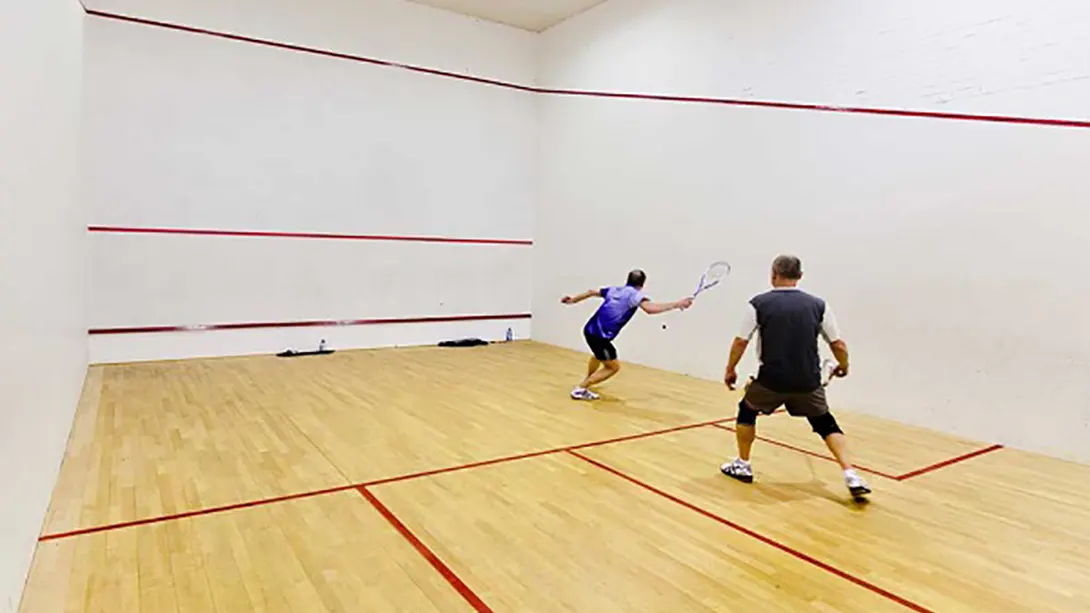12 September 2022 / 3-Min Read / Translate
There are a few variation of this condition game, but my favourite is the first one I learnt, which is that BOTH bounces must be in the designated area. The line defining front and back is of course the short line, and as with all squash points, if the ball hits the line it is out.
It's a fun condition game, that can be played for a set time in each position or scored as in a normal game. A traditional serve can be used, but I have always played it with a boast from the back player as the serve. If you use a traditional serve, then the front player would normally serve all the time, but it doesn't have to be that way.

One quick notice. Play safe at all times. There are no strokes in this condition game, only lets. If in doubt, just stop and play a let.
The front player has to play everything to the back, so there are no trickle/tickle boasts, no low kills and no last moment crosscourt flicks into the nick. They have to use width, height and tightness to win rallies. Because they don't have to worry about the front, they do not have to return all the way to the T, but they should come back at least near it, otherwise the back player won't have most of the front wall to hit the ball.
I mentioned height in the previous paragraph and this is a great game to improve you lobs, both straight and crosscourt, some make sure you use the full height of the court.
Another benefit to being at the front is the opportunity to practice some delay, deception and disguise when hitting your shots. Can you make your crosscourt drive look like a straight shot or vice versa? Where you make contact with the ball in relation to your leading knee is often a big clue as to where you are going to hit the ball. Either making contact in the same place each time or having full control over the ball irrespective of where the contact point is, is a very useful skill.
One last benefit is practicing your footwork. Specifically, which foot/leg to use on your forehand. I am a traditionalist and believe that you hit better shots using the opposite leg to your playing arm, i.e. your left leg if you are right-handed and your right leg if you are left-handed. That said, with modern rackets being so much lighter and the game faster than in the past, using the non-traditional leg can work and this game allows you to practice that.
Let me start with a reminder, you shots must take BOTH bounces before the short line to be considered in. You can't smack a drive that has its first bounce before the short line and think it's allowed - it's not.
Now, normally, playing all your shots to the front in a real game would be considered crazy - unless you are a genius with touch and control (maybe Ramy Ashour?), but here it's what you HAVE to do - yay! However, that doesn't mean you should be aiming for nick every single shot. That is not the purpose of this game for you. Your job is to move your opponent from side to side. Force them to hit a weak return that you can kill.
A sensible balance between straight, crosscourt and boasts shots is advisable. Don't neglect the straight probing shot. Ideally as close to the side wall as possible. It's also a chance to practice two and three-wall boasts. Crosscourts can be played but be safe. If the front player has not moved out of the way, don't play it.
Next, this is the perfect opportunity to develop better visual awareness of your opponent's swing. By that I mean, really watch them hit the ball and try to anticipate and then react to their shot. The more volleys you play as the back player, the better. But don't commit yourself too far forward or your opponent will be able to hit the ball past you easily.
So that leads onto practicing your reaction volleys, which is hard to do in all-court games. You need a short, but solid swing, more like a block than a swing. Watch the ball onto your strings and aim low, but not too low - you don't want to hit the tin!
The last benefit I will describe is the half-volley. I'll describe that fully tomorrow, but it's the shot played just after the ball has bounced. As the back player you can get to the ball early, especially a crosscourt and "push" it straight into the corner. if you have played it well, your opponent might not have much time to react.
It's an incredibly simple condition game, but incredibly useful. Both players get lots of benefits and it can be a great preparation game for training sessions as it's not too physically demanding.